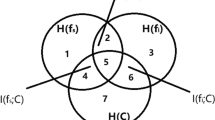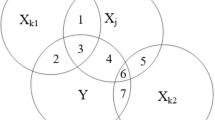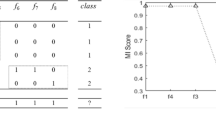Abstract
Feature selection plays an important role in pattern recognition and machine learning. Feature selection based on information theory intends to preserve the feature relevancy between features and class labels while eliminating irrelevant and redundant features. Previous feature selection methods have offered various explanations for feature relevancy, but they ignored the relationships between candidate feature relevancy and selected feature relevancy. To fill this gap, we propose a feature selection method named Feature Selection based on Weighted Relevancy (WRFS). In WRFS, we introduce two weight coefficients that use mutual information and joint mutual information to balance the importance between the two kinds of feature relevancy terms. To evaluate the classification performance of our method, WRFS is compared to three competing feature selection methods and three state-of-the-art methods by two different classifiers on 18 benchmark data sets. The experimental results indicate that WRFS outperforms the other baselines in terms of the classification accuracy, AUC and F1 score.








Similar content being viewed by others
References
Alonso-Betanzos A, Herrera F (2014) A review of microarray datasets and applied feature selection methods. Information Sciences An International Journal 282(5):111–135
Bai L, Wang Z, Shao YH, Deng NY (2014) A novel feature selection method for twin support vector machine. Knowl-Based Syst 59:1–8
Battiti R (1994) Using mutual information for selecting features in supervised neural net learning. IEEE Trans Neural Netw 5(4):537–550
Bennasar M, Hicks Y, Setchi R (2015) Feature selection using joint mutual information maximisation. Expert Syst Appl 42(22):8520–8532
Bolón-Canedo V., Sánchez-Maroño N, Alonso-Betanzos A (2015) Feature selection for high-dimensional data Springer
Che J, Yang Y, Li L, Bai X, Zhang S, Deng C, Fowler JE (2017) Maximum relevance minimum common redundancy feature selection for nonlinear data Information Sciences
Cheng H, Qin Z, Feng C, Wang Y, Li F (2011) Conditional mutual Information-Based feature selection analyzing for synergy and redundancy John Murray ...
Cover TM, Thomas JA (2003) Elements of information theory. Wiley, New Jersey
Dash M, Liu H (2003) Consistency-based search in feature selection. Artif Intell 151(1–2):155–176
Fleuret F (2004) Fast binary feature selection with conditional mutual information. J Mach Learn Res 5 (Nov):1531–1555
Freeman C, Kulić D., Basir O (2015) An evaluation of classifier-specific filter measure performance for feature selection. Pattern Recogn 48(5):1812–1826
Gao W, Hu L, Zhang P (2018) Class-specific mutual information variation for feature selection. Pattern Recogn 79:328–339
Hall MA (1999) Correlation-based feature selection for machine learning 19
He S, Chen H, Zhu Z, Ward DG, Cooper HJ, Viant MR, Heath JK, Yao X (2015) Robust twin boosting for feature selection from high-dimensional omics data with label noise. Inf Sci 291:1–18
Hoque N, Bhattacharyya DK, Kalita JK (2014) Mifs-nd: a mutual information-based feature selection method. Expert Syst Appl 41(14):6371–6385
Hu L, Gao W, Zhao K, Zhang P, Wang F (2018) Feature selection considering two types of feature relevancy and feature interdependency. Expert Syst Appl 93:423–434
Huang X, Zhang L, Wang B, Li F, Zhang Z (2017) Feature clustering based support vector machine recursive feature elimination for gene selection. Applied Intelligence (10) pp 1–14
Kira K, Rendell LA (1992) A practical approach to feature selection. In: International workshop on machine learning, pp 249–256
Lewis DD (1992) Feature selection and feature extraction for text categorization. In: Proceedings of the workshop on speech and natural language. Association for Computational Linguistics, pp 212–217
Li J, Cheng K, Wang S, Morstatter F, Trevino RP, Tang J, Liu H (2016) Feature selection: A data perspective. arXiv:1601.07996
Lichman M (2013) UCI machine learning repository http://archive.ics.uci.edu/ml
Moret-Bonillo V, Alonso-Betanzos A (2016) A comparison of performance of k-complex classification methods using feature selection. Inf Sci 328(C):1–14
Pascoal C, Oliveira MR, Pacheco A, Rui V (2016) Theoretical evaluation of feature selection methods based on mutual information. Neurocomputing 226(C):168–181
Peng H, Long F, Ding C (2005) Feature selection based on mutual information criteria of max-dependency, max-relevance, and min-redundancy. IEEE Transactions on pattern analysis and machine intelligence 27(8):1226–1238
Shannon CE (2001) A mathematical theory of communication. ACM SIGMOBILE Mobile Computing and Communications Review 5(1):3–55
Song L, Smola A, Gretton A, Bedo J, Borgwardt K (2012) Feature selection via dependence maximization. J Mach Learn Res 1(1):1393–1434
Tanveer M, Khan MA, Ho SS (2016) Robust energy-based least squares twin support vector machines. Appl Intell 45(1):174–186
Vergara J, Estevez PA (2014) A review of feature selection methods based on mutual information. Neural Comput & Applic 24(1):175–186
Vinh LT, Lee S, Park YT, d’Auriol BJ (2012) A novel feature selection method based on normalized mutual information. Appl Intell 37(1):100–120
Vinh NX, Zhou S, Chan J, Bailey J (2016) Can high-order dependencies improve mutual information based feature selection? Pattern Recogn 53(C):46–58
Wang J, Wei JM, Yang Z, Wang SQ (2017) Feature selection by maximizing independent classification information. IEEE Trans Knowl Data Eng 29(4):828–841
Wang Y, Feng L, Zhu J (2017) Novel artificial bee colony based feature selection method for filtering redundant information. Applied Intelligence (3)
Xuan VN, Chan J, Romano S, Bailey J (2014) Effective global approaches for mutual information based feature selection. In: ACM SIGKDD International conference on knowledge discovery and data mining, pp 512–521
Yang HH, Moody JE (1999) Data visualization and feature selection: New algorithms for nongaussian data. In: NIPS, vol. 12
Zeng Z, Zhang H, Zhang R, Yin C (2015) A novel feature selection method considering feature interaction. Pattern Recogn 48(8):2656–2666
Acknowledgements
This work was supported by the National Nature Science Foundation of China [grant number61772226,61373051, 61502343]; Science and Technology Development Program of Jilin Province [grant number 20140204004GX]; Science Research Funds for the Guangxi Universities [grant number KY2015ZD122]; Science Research Funds for the Wuzhou University [grant number 2014A002]; Project of Science and Technology Innovation Platform of Computing and Software Science (985 Engineering); Key Laboratory for Symbol Computation and Knowledge Engineering of the National Education Ministry of China; Fundamental Research Funds for the Central.
Author information
Authors and Affiliations
Corresponding author
Rights and permissions
About this article
Cite this article
Zhang, P., Gao, W. & Liu, G. Feature selection considering weighted relevancy. Appl Intell 48, 4615–4625 (2018). https://doi.org/10.1007/s10489-018-1239-6
Published:
Issue Date:
DOI: https://doi.org/10.1007/s10489-018-1239-6




